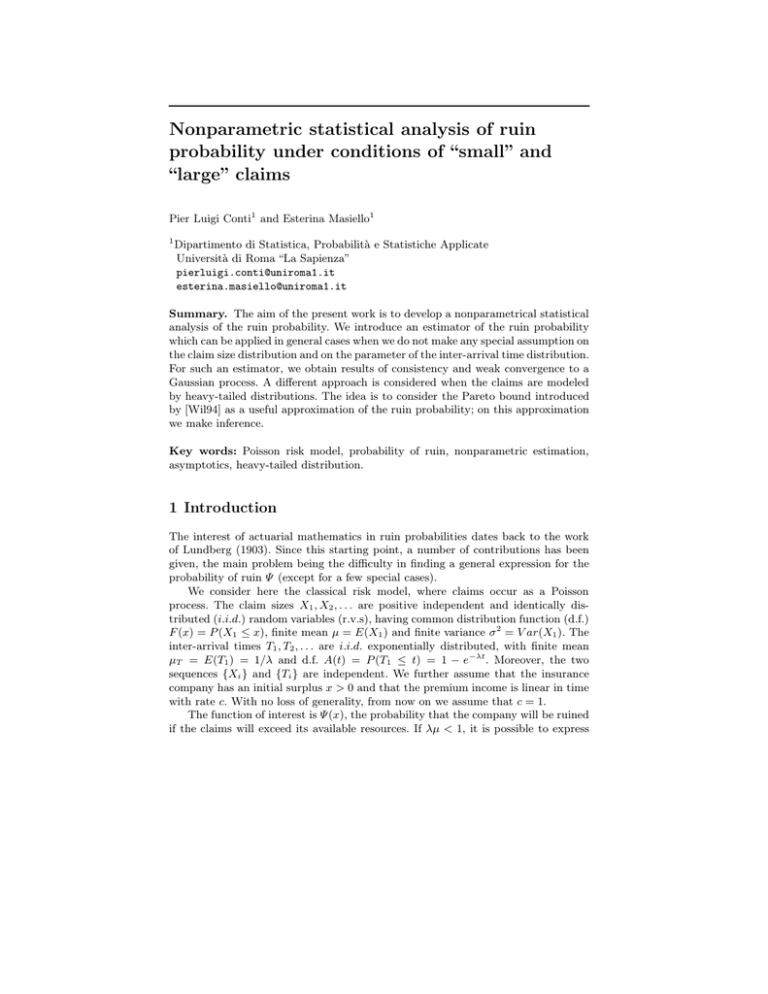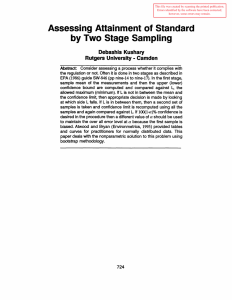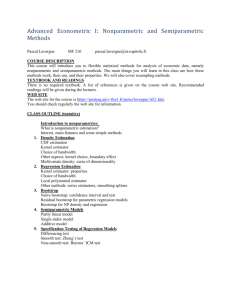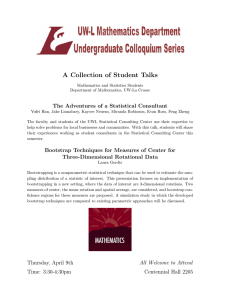Nonparametric statistical analysis of ruin probability under conditions of “small” and
advertisement

Nonparametric statistical analysis of ruin
probability under conditions of “small” and
“large” claims
Pier Luigi Conti1 and Esterina Masiello1
1
Dipartimento di Statistica, Probabilità e Statistiche Applicate
Università di Roma “La Sapienza”
pierluigi.conti@uniroma1.it
esterina.masiello@uniroma1.it
Summary. The aim of the present work is to develop a nonparametrical statistical
analysis of the ruin probability. We introduce an estimator of the ruin probability
which can be applied in general cases when we do not make any special assumption on
the claim size distribution and on the parameter of the inter-arrival time distribution.
For such an estimator, we obtain results of consistency and weak convergence to a
Gaussian process. A different approach is considered when the claims are modeled
by heavy-tailed distributions. The idea is to consider the Pareto bound introduced
by [Wil94] as a useful approximation of the ruin probability; on this approximation
we make inference.
Key words: Poisson risk model, probability of ruin, nonparametric estimation,
asymptotics, heavy-tailed distribution.
1 Introduction
The interest of actuarial mathematics in ruin probabilities dates back to the work
of Lundberg (1903). Since this starting point, a number of contributions has been
given, the main problem being the difficulty in finding a general expression for the
probability of ruin Ψ (except for a few special cases).
We consider here the classical risk model, where claims occur as a Poisson
process. The claim sizes X1 , X2 , . . . are positive independent and identically distributed (i.i.d.) random variables (r.v.s), having common distribution function (d.f.)
F (x) = P (X1 ≤ x), finite mean µ = E(X1 ) and finite variance σ 2 = V ar(X1 ). The
inter-arrival times T1 , T2 , . . . are i.i.d. exponentially distributed, with finite mean
µT = E(T1 ) = 1/λ and d.f. A(t) = P (T1 ≤ t) = 1 − e−λt . Moreover, the two
sequences {Xi } and {Ti } are independent. We further assume that the insurance
company has an initial surplus x > 0 and that the premium income is linear in time
with rate c. With no loss of generality, from now on we assume that c = 1.
The function of interest is Ψ (x), the probability that the company will be ruined
if the claims will exceed its available resources. If λµ < 1, it is possible to express
1502
Pier Luigi Conti and Esterina Masiello
Ψ as a compound geometric tail probability by mean of the so-called PollaczeckKhinchine formula (see, e.g., [Fel71] or [Asm00] for more detailed discussions):
Ψ (x) =
∞
X
∗k
(1 − ρ)ρk F I (x)
x≥0
k=1
(1)
Rx
where ρ = λµ, FI (x) = µ1 0 y dF (y) is the integrated tail distribution and F ∗k
denotes the k-fold convolution of the d.f. FI .
2 A nonparametric estimator for the ruin probability
In this section, we deal with the construction of a nonparametric estimator Ψn (x) of
Ψ (x) based on a sample T1 , . . . , Tn of inter-arrival times and a sample X1 , . . . , Xn
of corresponding claims. This problem has already been studied in [Pit94], in the
special case of a known value of ρ. We generalize here her results to the more realistic
case of an unknown value of ρ. Our only assumption is the stability of the model:
ρ < 1. Note that when ρ ≥ 1, the model is unstable and the ruin of the insurance
company occurs with probability 1. In fact, when ρ > 1 the expected claim payments
per unit time are greater than the insurer’s premium income per unit time. On the
other hand, when ρ = 1, λµ = c but the insurance company will be almost surely
ruined because of the effect of the variability of the claims.
The d.f. of inter-arrival times and claims are both supposed unknown. More
specifically, the inter-arrival time distribution is assumed to be exponential with
unknown parameter λ. As far as the claim distribution is concerned, no specific
parametric model is assumed.
Such a statistical problem has been considered by different authors but literature has mostly been concerned with asymptotic expansions; few results focus on
statistical estimation of Ψ . Clearly, one could work out a parametric estimation procedure or use nonparametric methods. As remarked in [Pit94], the latter approach
is particularly interesting in view of its applicability.
In our approach, the key tool for estimating the ruin probability is the PollaczeckKhinchine formula.
We first estimate E(T ) = µT by
its maximum likelihood estiP
Pn
1
mator T n = n1 n
i=1 Ti , and E(X) = µ by X n = n
i=1 Xi . The next step consists
in estimating ρ by the ratio ρ̂ = X n /T n . Finally, we replace the k-fold convolution
of F in (1) by the following estimator ([Fre86]):
!−1
Fn∗k (x)
=
n
k
X
I(Xi1 +...+Xi
k
≤x)
c
P
where
{i1 , i2 , . . . , ik } is a subset of size k of {1, 2, . . . , n} and c is the sum over all
n
different
combinations of {i1 , i2 , . . . , ik }.
k
We have easily estimated the quantities at the right hand side of (1) by the
corresponding sampling counterparts. It seems therefore natural to estimate Ψ (x)
by
Ψn (x) =
∞
X
∗k
(1 − ρ̂) ρ̂k F n (x)
k=1
Nonparametric statistical analysis of ruin probability
1503
The asymptotic behavior of the proposed estimator has been investigated. Our main
results are summarized in the following theorem.
Theorem 1. Under the assumption ρ < 1, as n → ∞, we have:
a.s.
(i) supx |Ψn (x) − Ψ (x)| → 0
√
(ii) the sequence of stochastic processes { n(Ψn (x) − Ψ (x)); x ≥ 0}n≥1 converges
weakly (in the Skorokhod topology in D[0, ∞]) to a Gaussian process Z with
mean function 0 and covariance kernel given by:
E[Z(x)Z(y)] =
∞
∞ X
X
k=1 j=1
+
∞ X
∞
X
′
fk (ρ)F
∗k
(1 − ρ)2 ρk+j k j Cov(F
′
∗j
(x)fj (ρ)F (y)
k=1 j=1
+2
∞ X
∞
X
k=1 j=1
(1 − ρ)ρk
∗k−1
(x − X1 ), F
µ2
1 2
σ + 4 σT2
2
µT
µT
∗j−1
(y − X1 ))
1 ′
∗j
∗k−1
(x − X1 ))
f (ρ)F (y) Cov(X1 , F
µT j
This result can be used to construct confidence bands for Ψ (x), based on resampling
techniques.
3 Ruin probability under “high claims”
Almost all analytical studies of the probability of ruin in risk business have been
based on the assumption that the moment generating function (m.g.f.) of the claim
size distribution is finite for some positive real argument. What happens to the ruin
probability of an insurer who is incurring “large claims” modeled by distributions
with heavy tails, which do not have exponential moments?
The estimator proposed in the above section, which naturally arises for the ruin
probability, is essentially based on the empirical distribution function Fn and this
involves a bad accuracy on the tails. As a consequence, when dealing with heavytailed distributions, we are forced to resort to a different approach. The basic idea is
to resort to an appropriate approximation of Ψ (x) (“for x large”) and estimate this
approximation.
The main result in this direction is the celebrated Lundberg’s inequality. Assume
that the Cramér-Lundberg condition holds, i.e. there exists a positive constant R
(the so-called adjustment coefficient) such that:
Z
0
∞
eRx F (x)dx < ∞
Then, Lundberg’s inequality states a bound which is exponential in the initial capital
x:
Ψ (x) ≤ e−Rx
∀x ≥ 0
(2)
The problem is that for many practical distributions, Lundberg’s inequality is not
available because of the non-existence of the corresponding adjustment coefficients.
1504
Pier Luigi Conti and Esterina Masiello
Refinements and generalizations of the inequality (2) have been considered by
several authors. A simple approach to the problem consists in constructing a bound
for the tail of the claim size distribution which is based on the reciprocal of a
polynomial of order m, when at least m moments of the claim size distribution
exist.
Following this idea, Willmot ([Wil94]) obtains the so-called Pareto bound which,
applied to the ruin probability Ψ (x), becomes:
Ψ (x) ≤ (1 + kx)−m
x≥0
(3)
where k > 0 satisfies the relationship:
Z
∞
(1 + kx)m dF (x) =
0
1
ρ
and m > 0 is the lowest upper bound for the number of moments possessed by the
claim size distribution.
The moment based bound introduced by [Wil94] can be considered as a useful
approximation of Ψ (x). We make inference on this approximation. The problem
we study is the construction of nonparametric point and interval estimates for the
bound (1 + kx)−m at the right hand side of relation (3).
Again, we do not assume any specific parametric model for the distribution of
the claims, while Ti ’s are assumed i.i.d. exponential r.v.s with unknown parameter
λ. Let T1 , . . . , Tn and X1 , . . . , Xn be two samples of inter-arrival times and claims,
respectively. Our idea is to estimate F (x) by the corresponding empirical d.f. Fn (x)
and ρ by ρ̂ = X n /T n so that it is possible to define kn as the solution to the equation
Z
0
∞
(1 + kx)m dFn (x) −
1
=0
ρ̂
Now, it seems natural to consider (1 + kn x)−m as an estimate for the Pareto upper
bound (1 + kx)−m at the right hand side of relation (3). Our main results are
asymptotic results about the behavior of this estimator of the Pareto bound. They
are stated in the following theorem.
Theorem 2. Under the assumption ρ < 1, as the sample size n goes to infinity, the
following results hold true.
a.s.
(i) (1 + kn x)−m → (1 + kx)−m
∀ x ≥ 0.
√
(ii) The sequence of r.v.s n((1 + kn x)−m − (1 + kx)−m ) converges in law to a
normal distribution with mean 0 and variance σ2 = (m2 (1 + kx)−2(m+1) x2 )σk2 .
a.s.
(iii) Let σ 2n = (m2 (1 + kn x)−2(m+1) x2 )σ̂k2 , then σ 2n → σ2 .
(iv) Let qα/2 be the α/2-th quantile of the normal standard distribution. A confidence
interval for (1 + kx)−m , with asymptotic size (1 − α), is given by
√
√
[(1 + kn x)−m − qα/2 σ̄n / n, (1 + kn x)−m + qα/2 σ̄n / n]
The confidence interval for (1 + kx)−m obtained in the above theorem is based
on the asymptotic normality of our estimator. The distribution of (1 + kn x)−m
is usually not symmetric around (1 + kx)−m (as supported by data provided in
the sequel). Hence, we cannot expect that confidence intervals which are symmetric
around (1+kn x)−m will perform well. Bootstrap confidence interval should be a good
Nonparametric statistical analysis of ruin probability
1505
alternative to normal intervals because they are in general not symmetric around
√
(1 + kx)−m . Hence, the bootstrap distribution of n((1 + kn x)−m − (1 + kx)−m )
should recover the asymmetry of the actual distribution.
To construct a bootstrap confidence interval, we first generate mn bootstrap
∗
∗
claim samples (X1,j
, . . . , Xn,j
), (j = 1, . . . , mn ), and mn independent bootstrap
∗
∗
∗
inter-arrival time samples (T1,j
, . . . , Tn,j
), (j = 1, . . . , mn ). Let P
us denote by kn,j
n
∗
m
the root of the equation Gn,j (k, m) = 0, where Gn (k, m) = (1/n) i=1 (1 + kXi ) −
√
∗
∗
n((1 + kn,j
x)−m − (1 + kn x)−m ),
1/ρ̂, and define the mn quantities Vn,j
=
(j =
1, . . . , mn ). We can compute the empirical distribution function R̂n (x) =
Pmn
∗
∗
1
j=1 I(−∞,x] (Vn,j ) and approximate the α-th quantile of R̂n (x) = P (Vn,j ≤ x)
mn
by
R̂n−1 (α) = inf{x : R̂n (x) ≥ α}
Finally, the bootstrap confidence interval is given by
[(1 + kn x)−m − R̂n−1 (1 − α/2)n−1/2 , (1 + kn x)−m − R̂n−1 (α/2)n−1/2 ]
3.1 A simulation study
The present subsection is devoted to a simulation study performed in order to compare the coverage probabilities of bootstrap and asymptotic confidence intervals for
(1 + kx)−m . We suppose that the inter-arrival time distribution is exponential of
parameter λ with d.f. A(t) = 1 − e−λt . The claim size distribution is assumed to be
Pareto of scale parameter β > 0, shape parameter α > 0 and d.f. F (t) = 1 − (β/t)α
with t ≥ β. The Pareto distribution seems to describe rather well the claim size
distribution in insurance in models with many small claims and few large ones (it
is the case of extreme values among the claims). Moreover, the moment generating
function for such a distribution is not defined.
The values for the parameters considered in our study are shown in Table 1 (when
ρ = 0.2), in Table 2 (when ρ = 0.5) and in Table 3 (when ρ = 0.8). Obviously, the
choice of a particular value for the parameter m depends on the moment assumptions
that we want to make about F (the values m = 1, 1.5, 2, 2.5 are covered in our study).
Table 1. Values of m, α, β, EX, λ, ET , k0 , x1 , x2 when ρ = 0.2.
m
1
1.5
2
2.5
α
2.1
3.1
4.1
5.1
β
1048
27.1
45.37
64.31
EX
20
40
60
80
λ
0.01
0.005
0.0033
0.0025
ET
100
200
300
400
k0
0.2097208
0.0468165
0.01914081
0.01074617
x1
19.1
41.1
64.6
84.1
x2
419.3
456.4
426.6
458.9
For every choice of (α, β, λ), 500 pairs of independent inter-arrival times and
claims samples of size n have been generated by Monte Carlo method. The two
sample sizes n = 100 and n = 200 have been considered. A grid of values has been
chosen for the initial surplus x in such a way that either (1 + kx)−m = 0.2 or
(1 + kx)−m = 0.01. The corresponding surplus values have been denoted by x1 and
x2 , respectively. This particular choice comes from our interest in considering the
1506
Pier Luigi Conti and Esterina Masiello
Table 2. Values of m, α, β, EX, λ, ET , k0 , x1 , x2 when ρ = 0.5.
m
1
1.5
2
2.5
α
2.1
3.1
4.1
5.1
β
12.57
32.52
54.44
77.17
EX
24
48
72
96
λ
0.020833
0.010416
0.006944
0.005208
ET
48
96
144
192
k0
0.05026794
0.01125278
0.005722792
0.003173154
x1
79.6
171.0
216.0
284.8
x2
2235.1
1587.6
1625.7
1589.4
Table 3. Values of m, α, β, EX, λ, ET , k0 , x1 , x2 when ρ = 0.8.
m
1
1.5
2
2.5
α
2.1
3.1
4.1
5.1
β
15.71
40.64
68
96.47
EX
30
60
90
120
λ
0.026666
0.01333
0.00888
0.00666
ET
37.5
75
112.5
150
k0
0.009429673
0.00282884
0.001247634
0.000795483
x1
424.2
680.1
990.7
1136.0
x2
11276.2
8598.8
6662.9
6678.9
tail of the distribution rather than the whole distribution. For every pair of samples
of inter-arrival times and claims, we have computed the value (1 + kn x)−m . In such
a way, we have obtained the simulated distributions of (1 + kn x)−m for different
values of ρ, n, m and x. In Tables 4 and 5, skewness (sk) and kurtosis (ku) measures
for the simulated distributions of (1 + kn x)−m are displayed.
Table 4. Values of skewness and kurtosis when x = x1 .
n = 100
ρ m=1
0.2 sk 4.98
ku 64.7
0.5 sk 1.9
ku 10.2
0.8 sk 2.2
ku 9.3
m = 1.5
sk 0.5
ku 3.8
sk 1.0
ku 4.5
sk 2.1
ku 8.3
m=2
sk 0.3
ku 3.0
sk 0.8
ku 4.0
sk 2.1
ku 8.0
m = 2.5
sk 0.4
ku 3.5
sk 0.8
ku 4.5
sk 2.0
ku 7.4
n = 200
m=1
sk 1.6
ku 10.3
sk 1.4
ku 7.6
sk 2.5
ku 11.2
m = 1.5
sk 0.5
ku 3.4
sk 0.6
ku 3.2
sk 2.0
ku 8.0
m=2
sk 0.3
ku 3.1
sk 0.8
ku 4.7
sk 2.3
ku 12.0
m = 2.5
sk 0.4
ku 3.2
sk 0.8
ku 4.5
sk 1.6
ku 6.7
It clearly appears that generally the distribution of (1 + kn x)−m is asymmetric
and far from normality. More specifically, data suggest that the higher is ρ the more
asymmetric is the distribution of (1 + kn x)−m . For each sample size (n = 100 and
n = 200) after having simulated 500 data sets, we have computed the corresponding
confidence interval of nominal level 0.95 (α = 0.05) and counted the number of
cases in which (1 + kx)−m , the true value, was covered by the confidence interval.
The coverage probabilities for asymptotic and bootstrap confidence intervals (ca and
cb, respectively) with a nominal level 0.95, obtained on the basis of the simulated
samples, are shown in Table 6 for the case n = 100 and n = 200 when x = x1 and
in Table 7 for n = 100 and n = 200 when x = x2 .
It turns out that the level of the bootstrap confidence intervals, as well as the level
of the asymptotic confidence intervals, becomes considerably smaller than 1−α when
ρ increases. The same “bad” behavior has occurred with n = 200 instead of n = 100,
even if changing from sample size n = 100 to n = 200 generally increases the coverage
Nonparametric statistical analysis of ruin probability
1507
Table 5. Values of skewness and kurtosis when x = x2 .
n = 100
ρ m=1
0.2 sk 3.1
ku 25.5
0.5 sk 1.7
ku 7.6
0.8 sk 8.9
ku 87.0
m = 1.5
sk 0.9
ku 4.7
sk 1.9
ku 10.6
sk 5.9
ku 47.1
m=2
sk 0.8
ku 4.2
sk 2.5
ku 15.9
sk 9.2
ku 103.6
m = 2.5
sk 0.8
ku 3.9
sk 3.9
ku 37.8
sk 9.4
ku 126.4
n = 200
m=1
sk 1.2
ku 6.5
sk 16.7
ku 314.4
sk 13.8
ku 235.5
m = 1.5
sk 0.5
ku 3.2
sk 0.7
ku 3.8
sk 10.1
ku 139.4
m=2
sk 0.3
ku 2.8
sk 1.5
ku 6.8
sk 10.8
ku 171.3
m = 2.5
sk 0.7
ku 3.5
sk 1.5
ku 7.4
sk 8.3
ku 88.7
m=2
ca 0.974
cb 0.97
ca 0.952
cb 0.93
ca 0.914
cb 0.832
m = 2.5
ca 0.974
cb 0.976
ca 0.97
cb 0.958
ca 0.9
cb 0.834
Table 6. Coverage probabilities ca and cb when x = x1 .
n = 100
ρ m=1
0.2 ca 0.972
cb 0.944
0.5 ca 0.944
cb 0.9
0.8 ca 0.866
cb 0.722
m = 1.5
ca 0.98
cb 0.962
ca 0.97
cb 0.944
ca 0.902
cb 0.77
m=2
ca 0.972
cb 0.97
ca 0.97
cb 0.948
ca 0.92
cb 0.758
m = 2.5
ca 0.972
cb 0.964
ca 0.944
cb 0.914
ca 0.93
cb 0.794
n = 200
m=1
ca 0.98
cb 0.968
ca 0.964
cb 0.918
ca 0.928
cb 0.826
m = 1.5
ca 0.984
cb 0.976
ca 0.964
cb 0.942
ca 0.914
cb 0.834
probability and makes better the performance of the bootstrap confidence intervals:
the level 95% confidence intervals has an actual coverage probability between 69%
and 97% when n = 100 and between 78% and 97% when n = 200.
Table 7. Coverage probabilities ca and cb when x = x2 .
n = 100
ρ m=1
0.2 ca 0.958
cb 0.918
0.5 ca 0.922
cb 0.862
0.8 ca 0.822
cb 0.694
m = 1.5
ca 0.98
cb 0.96
ca 0.946
cb 0.892
ca 0.878
cb 0.746
m=2
ca 0.974
cb 0.944
ca 0.96
cb 0.902
ca 0.876
cb 0.746
m = 2.5
ca 0.966
cb 0.946
ca 0.942
cb 0.874
ca 0.872
cb 0.748
n = 200
m=1
ca 0.972
cb 0.948
ca 0.95
cb 0.888
ca 0.878
cb 0.782
m = 1.5
ca 0.982
cb 0.972
ca 0.956
cb 0.924
ca 0.904
cb 0.79
m=2
ca 0.978
cb 0.962
ca 0.964
cb 0.936
ca 0.878
cb 0.792
m = 2.5
ca 0.97
cb 0.948
ca 0.948
cb 0.916
ca 0.908
cb 0.794
On the other hand, the number of 500 Monte Carlo trials is rather small and
does not give us precise information on the actual level of our confidence sets but
a larger scale Monte Carlo study with 1000 or more trials is a computer time consuming task. Also observe that the cycle of bootstrap replications is “double”: we
need bootstrap replications to compute the coverage probability and to compute the
bootstrap quantile in bootstrap confidence intervals.
1508
Pier Luigi Conti and Esterina Masiello
References
[Asm00] Asmussen, S.: Ruin probability. World scientific, Singapore (2000)
[Bil68]
Billingsley, P.:Convergence of probability measures. John Wiley, New York
(1968)
[EKM97] Embrechts, P., Kl¨uppelberg, C., Mikosch, T.: Modeling extremal events
in insurance and finance. Springer-Verlag, Berlin (1997)
[Fel71]
Feller, W.: An introduction to probability theory and its applications II.
Wiley, New York (1971)
[Fre86] Frees, E.W.: Nonparametric renewal function estimation. The Annals of
Statistics, 14, 1366–1378 (1986)
[HOS95] Harel, M., O’ Cinneide, C.A., Schneider, H.: Asymptotics of the sample
renewal function. Journal of mathematical analysis and applications, 189,
240–255 (1995)
[Lun03] Lundberg, F.: Approximerad Framställning av Sannolikhetsfunktionen.
Aterförsäkring av Kollektivrisker, II, Almqvist & Wiksell, Uppsala (1903)
[Pit94]
Pitts, S.M.: Nonparametric estimation of compound distributions with
applications in insurance. Ann. Inst. Statist. Math., 46, No. 3, 537–555
(1994)
[VW96] Van der Vaart, A.W., Wellner, J.A.: Weak convergence and empirical processes. Springer-Verlang (1996)
[Wil94] Willmot, G. E.: Refinements and distributional generalizations of Lundberg’s inequality. Insurance: Math. Econom., 15, 49–63 (1994)
[WL00] Willmot, G.E., Lin, X.S.: Lundberg approximations for compound distributions with insurance applications. Springer-Verlang, Berlin (2000)





